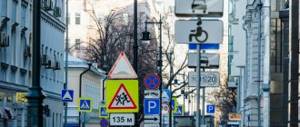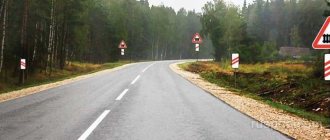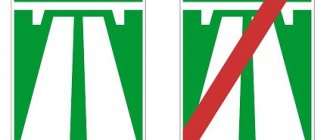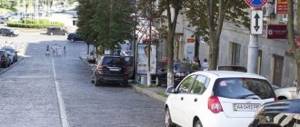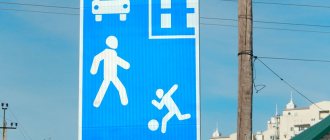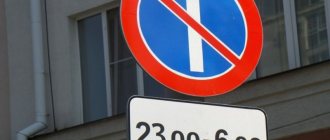Cycling is a popular sport, however, to preserve personal safety, it is necessary to use this type of transport only in designated areas.
Special places where you can travel on such a vehicle have a “cycle path sign”. This designation means that cycling and other types of transport are prohibited on this section of the road.
What does the bike lane sign mean?
Externally, the sign looks like a white bicycle, which is placed on a blue background; the sign itself is round.
This designation means that the area is intended for riding two-wheeled vehicles, while the following features must be observed for other road users:
- vehicles must not cross the zone and use the roadway as a parking space;
- Pedestrians should not travel in the bicycle zone. An exception may be the fact that there is no sidewalk, but the pedestrian must not interfere with the movement of the bicycle.
This type of road is intended for traveling on two-wheelers and scooters.
The main purpose of the bike path is:
- complete safety of travel participants;
- reducing the occurrence of accidents on the roads.
Let's celebrate! Recently, the number of such equipped places for cycling has been growing rapidly. In European countries, the presence of bicycle roads is mandatory, since a large number of residents travel by this type of transport.
What does a bike lane sign look like?
Fines for bike lanes
In the territory marked with the symbol 4.4.1, you can only drive a non-mechanical vehicle, as well as a moped or scooter. Cars have nothing to do there. But drivers often ignore the ban. Violators face Part 2 of Article 12.15 of the Administrative Code:
Driving on bicycle or pedestrian paths or sidewalks in violation of the Traffic Rules entails an administrative fine of two thousand rubles.
Stopping and parking in the zone of influence of 4.4.1 is also prohibited by one of the provisions of paragraph 12.4 of the traffic rules. For these actions, the car driver will receive a fine of 500 rubles. in accordance with Part 1 of Article 12.19 of the Code. And in both cases, the traffic police officer has the right to apply Part 1 of Article 12.16 of the Code of Administrative Offenses (ignoring the requirements of signs and markings), that is, to demand payment of another 500 rubles.
More on AutoLex.Net:
Available about who is giving way in the yard, a sign for entering the yard
Theoretically, a pedestrian can also be punished for using a bicycle path. After all, this category of traffic participants has the right to move in the zone of influence of symbol 4.4.1 only in the absence of a sidewalk. Pedestrians should stay to the right and not interfere with cyclists.
Otherwise, you can run into a fine of 500 rubles. according to Part 1 of Art. 12.29 Code of Administrative Offenses or a warning from a traffic police inspector. This, of course, does not mean that the driver of a non-motorized vehicle or moped can hit a pedestrian with impunity.
The “Bicycle path” sign is still rarely seen in Russia. And it causes bewilderment among many motorists, and some completely neglect it. And in vain, because the number of cyclists is growing every year. This means that the number of separate lanes and separate zones for them will also increase.
Types of sign
Depending on the type of road on which cycling occurs, the signs may have distinctive features.
Tracks can be of various types:
One-way – designed for cyclists to ride in one direction; this type of route has the following features:
- are marked with a special sign;
- has a slight elevation from other movement areas;
- separated from roads by a special buffer zone.
Two-way – cyclists can travel in different directions. Most often they are located in places with a large number of attractions. Also very often this type of road can be found on embankments.
Combined - this type most often adjoins sidewalks and is located at a distance from the highway.
Isolated - designed not only for movement on two-wheeled vehicles, but also for pedestrians.
Good to know! Each type of road must be marked with a corresponding sign at the beginning of the coverage area and at its end, thereby notifying cyclists of the end of the bicycle road.
Where the sign is installed, its coverage area
This designation can be found in the following places:
- to the right of the marked traffic zone, separated from the sidewalk or roadway by curbs or grass;
- over an area that looks like a marked road on the right side of the roadway. Additionally, it must be established about.
This type of marking can be found in parks and plaza areas. In big cities, bicycle paths are also located in the city center for convenient travel.
The effect of such a designation begins directly in the place where the corresponding mark is placed. If there is an intersection or a turn on the path, after crossing which there is no sign, this means that the zone is over for cycling.
For those roadways where there is no “Bicycle Path” designation, but a bicycle is painted on the asphalt, this means that not only cyclists, but also cars can move along the designated area.
Note! The end of a two-wheeler trail must be marked with a sign showing a bicycle on a blue background, with a red line through it.
What it looks like on the asphalt, coloring book
There is a sign where the bike path begins, and there is also painting on the surface of the road. This is horizontal marking 1.23.3. It is a white image of a bicycle. Sometimes an arrow is drawn just below, showing the direction of movement.
A “Bike Path” sign on the asphalt has the same meaning as one located above the road. He indicates that only non-motorized vehicles and mopeds are allowed to travel from this place. The territory ends with symbol 4.4.2.
No bicycle lane sign
On some sections of the roadway, cycling can be dangerous and therefore prohibited. Then there must be a sign “No bicycle path”. It is numbered 3.9 and has a slightly different name. The symbol is round, is an image of a non-mechanical vehicle on a white background, with a red border along the edge.
The exact name of 3.9 is “No cycling”. It contains a requirement that must be met from the installation site. 3.9 can be found:
- in front of a bridge, tunnel, overpass;
- at the beginning of the high-speed section of the route;
- in front of the industrial zone;
- at the beginning of the protected natural area.
Sometimes a non-mechanical vehicle is not allowed to drive in only one direction. Then next to 3.9 they put signs 8.3.1-8.3.3.
More on AutoLex.Net:
What does the concept of “ensuring road safety” include, organizing road safety
Its influence ends at the nearest intersection. And if there is a sign next to 3.9, 8.2.1, you need to use it to judge where the symbol’s coverage area will end. After all, this sign indicates the distance at which its requirements should be met.
Watch this video about the concept of “Bike path”:
Sign “Intersection with a bicycle path”: appearance, rules of passage
The sign “Intersection with a bicycle path” (1.24) is directly related to non-motorized vehicles. Other road users should also be attentive to it. After all, the symbol warns that a cyclist may be in the path of the car.
Sign 1.24
1.24 according to GOST it is established:
- in a city or village - 100-150 m before the intersection of the bicycle road and the road;
- outside the populated area - 150-300 m before it;
- at the distance indicated on plate 8.1.1 if it is next to 1.24.
Previously, this symbol determined the priority of a mechanical vehicle. And the cyclist or moped driver was obliged to let the car pass. But now this clause has been excluded from the traffic rules. And the intersection of a bike path with a road is considered an intersection. If it is not regulated, there are no priority symbols, the rules of passage are:
At an intersection of equivalent roads, except in the case provided for in paragraph 13.11(1) of the Rules, the driver of a trackless vehicle is obliged to give way to vehicles approaching from the right.
That is, when a cyclist comes from this side, the car gives way. If they change roles, the driver of a non-motorized vehicle must wait.
All this means that a motorist cannot drive in the 1.24 zone, as in the expressway. At the border of the sign, he should slow down so that if something happens he has time to brake smoothly.
In addition, we should not forget about clause 13.1 of the traffic rules:
When turning right or left, the driver must give way to pedestrians and cyclists crossing the roadway onto which he is turning.
You cannot overtake in the influence zone 1.24; maneuvering in this area is dangerous. It is also prohibited to drive in reverse, as required by paragraph 8.12 of the traffic rules:
Reversing is prohibited at intersections and in places where turning around is prohibited in accordance with paragraph 8.11 of the Rules.
Speed and order of movement
When riding, a cyclist must follow some general rules:
- in order to turn in any direction, you need to raise your arm bent at the elbow in the direction of the turn;
- When braking, you should raise your hand;
- when entering the path from the roadway, you must indicate with an outstretched arm the direction in which the movement will take place;
- it is necessary to cross streets at intersections only after the cyclist has made sure that vehicles allow him to pass;
- if, when crossing a pedestrian path and a highway (the corresponding sign 1.24 should hang), a cyclist needs to cross the road, he must slow down and let vehicles pass, only then continue on his way;
- If there is no special path for driving, you must cross the highway, including at a pedestrian crossing, on foot.
In many countries where such a means of transport is developed, there are special traffic lights in driving areas.
The speed of movement in the city should not exceed 60 km/h, in densely populated areas (in courtyards and parks) the speed should not exceed 20 km.
Let's celebrate! That children under 14 years of age do not have the right to move independently on the road without an appropriate mark.
Road signs for pedestrians and cyclists
- "End of pedestrian and cycle path with traffic separation." This means that the divided section of road for pedestrians and cyclists ends.
- "Footpath". The sign indicates that traffic is permitted for pedestrians and cyclists in accordance with the rules of the road.
- "Road with a lane for cyclists." Indicates the beginning of the road along which the movement of cyclists and moped drivers is carried out along a specially designated lane towards the general flow of vehicles.
- "The end of the road with a lane for cyclists." The road sign indicates that there is no lane for cyclists further on the roadway.
- “Entering a road with a lane for cyclists.” Indicates that further down the road a special lane for cyclists begins.
- Lane for cyclists" This sign is valid only on the lane in front of which it is placed. It means that a lane begins on the road reserved only for cyclists. The effect of signs installed on the right of the road extends to the right lane.
- "The end of the lane for cyclists"
The effect of signs installed on the right of the road extends to the right lane. Indicates that the lane designated specifically for cyclists no longer continues.
- "Artificial Roughness" The sign lets you know about irregularities on the road. Install it at the nearest boundary of the artificial bump relative to approaching vehicles.
- "Living sector". This sign is installed before the start of a residential zone, in which drivers of all vehicles are required to reduce speed.
- "Pedestrian zone". The sign marks the beginning of a road intended for pedestrians only. A cyclist has no right to travel on this road.
- "Motorway". Indicates an exit to a motorway. Cyclists are required to follow the rules of the road for this type of road.
- "Crosswalk". This sign warns that there is a pedestrian crossing area ahead. The sign is installed to the right of the road relative to the approaching vehicle.
- "No entry". Prohibits the entry of all vehicles in this direction. The sign does not apply to route vehicles.
- "Movement Prohibition". All vehicles are prohibited. Does not apply to route vehicles, special vehicles for transporting disabled people and government transport.
- "Bicycles are prohibited." The movement of bicycles and mopeds on a certain section of the road is prohibited.
